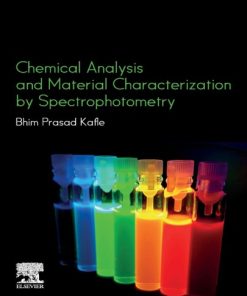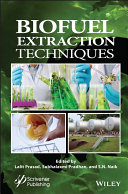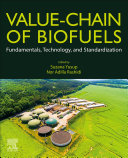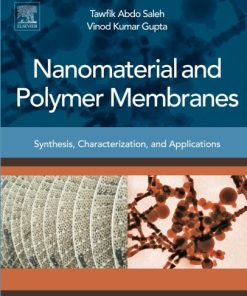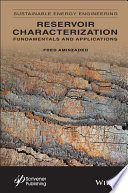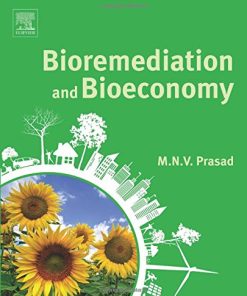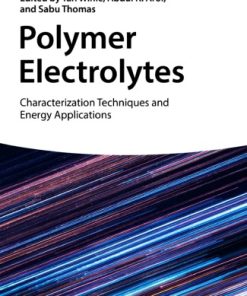Liquid Biofuels Fundamentals Characterization and Applications 1st Edition by Krushna Prasad Shadangi 1119793017 9781119793014
$50.00 Original price was: $50.00.$25.00Current price is: $25.00.
Liquid Biofuels: Fundamentals, Characterization, and Applications 1st Edition by Krushna Prasad Shadangi – Ebook PDF Instant Download/DeliveryISBN: 1119793017 9781119793014
Full download Liquid Biofuels: Fundamentals, Characterization, and Applications 1st Edition after payment.
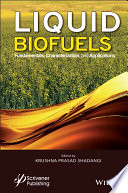
Product details:
ISBN-10 : 1119793017
ISBN-13 : 9781119793014
Author : Krushna Prasad Shadangi
Compiled by a well-known expert in the field, Liquid Biofuels provides a profound knowledge to researchers about biofuel technologies, selection of raw materials, conversion of various biomass to biofuel pathways, selection of suitable methods of conversion, design of equipment, selection of operating parameters, determination of chemical kinetics, reaction mechanism, preparation of bio-catalyst: its application in bio-fuel industry and characterization techniques, use of nanotechnology in the production of biofuels from the root level to its application and many other exclusive topics for conducting research in this area. Written with the objective of offering both theoretical concepts and practical applications of those concepts, Liquid Biofuels can be both a first-time learning experience for the student facing these issues in a classroom and a valuable reference work for the veteran engineer or scientist.
Liquid Biofuels: Fundamentals, Characterization, and Applications 1st Table of contents:
1 Introduction to Biomass to Biofuels Technologies
1.1 Introduction
1.2 Lignocellulosic Biomass and Its Composition
1.3 Types and Category of the Biomass
1.4 Methods of Conversion of Biomass to Liquid Biofuels
1.5 Bioethanol and Biobutanol Conversion Techniques
1.6 Biogas and Syngas Conversion Techniques
1.7 Advantages and Drawbacks of Biofuels
1.8 Applications of Biofuels
1.9 Future Prospects
1.10 Conclusion
References
2 Advancements of Cavitation Technology in Biodiesel Production – from Fundamental Concept to Commercial Scale-Up
2.1 Introduction
2.2 Principles of Ultrasound and Cavitation
2.3 Intensification of Biodiesel Production Processes Through Cavitational Reactors
2.4 Designing the Cavitation Reactors
2.5 Scale-Up of Cavitational Reactors
2.6 Application of Cavitational Reactors for Large-Scale Biodiesel Production
2.7 Future Prospects and Challenges
References
3 Heterogeneous Catalyst for Pyrolysis and Biodiesel Production
3.1 Biodiesel Production
3.2 Plastic Pyrolysis
3.3 Conclusion
References
4 Algal Biofuel: Emergent Applications in Next-Generation Biofuel Technology
4.1 Introduction
4.2 Burgeoning of Biofuel Resources
4.3 Common Steps Adopted for Microalgal Biofuel Production
4.4 Types of Microalgal Biofuels and their Emerging Applications
4.5 Conclusion
References
5 Co-Liquefaction of Biomass to Biofuels
5.1 Introduction
5.2 Hydrothermal Liquefaction (HTL)
5.3 Co-Liquefaction of Biomass
5.4 Current Development, Challenges and Future Perspectives
5.5 Conclusions
Acknowledgments
References
6 Biomass to Bio Jet Fuels: A Take Off to the Aviation Industry
6.1 Introduction
6.2 The Transition of Biomass to Biofuels
6.3 Properties of Aviation Jet Fuel (Bio-Jet Fuel)
6.4 Fuel Specification for Civil Aviation
6.5 Choice of Feedstock (Renewable Sources)
6.6 Pathways of Biomass to Bio-Jet Fuels
6.7 Challenges Associates with the Future of Bio-Jet Fuel Development
6.8 Future Perspective
6.9 Conclusion
Acknowledgements
References
7 Advance in Bioethanol Technology: Production and Characterization
7.1 Introduction
7.2 Production Technology of Ethanol and Global Players
7.3 Microbiology of Bioethanol Production
7.4 Fermentation Technology
7.5 Downstream Process
7.6 Ethanol Analysis
7.7 Conclusion
References
8 Effect of Process Parameters on the Production of Pyrolytic Products from Biomass Through Pyrolysis
8.1 Introduction
8.2 Biomass to Energy Conversion Technologies
8.3 Advantages of Pyrolysis
8.4 Effect of Processing Parameters on Liquid Oil Yield
8.5 Types of Reactors
8.6 Advantages and Disadvantages of Different Types of Reactors
8.7 Conclusion
Acknowledgements
References
9 Thermo-Catalytic Conversion of Non-Edible Seeds (Extractive-Rich Biomass) to Fuel Oil
9.1 Introduction
9.2 Thermochemical Technologies for Liquid Biofuel Production
9.3 Feedstock Classification for Biofuel Production
9.4 Characterization of Non-Edible Oil Seeds
9.5 Thermal Degradation Profile of Different Non-Edible Seeds
9.6 Preparation of Raw Materials for Pyrolysis
9.7 Catalytic and Non-Catalytic Thermal Conversion for Liquid Fuel Production
9.8 Need for Up-Gradation of Pyrolytic Oil
9.9 Application of Catalyst in Pyrolysis of Non-Edible Biomass
9.10 Effect of Parameters on Liquid Fuel Production
9.11 Fuel Properties of Thermal and Catalytic Pyrolytic Oil
9.12 Challenges in Utilization of Nonedible Oil Seed in Themocatalytic Conversion Process
9.13 Advantages and Drawbacks of Seed Pyrolytic Oils
9.14 Precautions Associated with the Application of Biofuel
9.15 Conclusion and Future Perspectives
References
10 Suitability of Oil Seed Residues as a Potential Source of Bio-Fuels and Bioenergy
10.1 Introduction
10.2 Biomass Conversion Processes
10.3 Biomass to Bioenergy via Thermal Pyrolysis
10.4 Physicochemical Characterization of Bio-Oil
10.5 Engine Performance Analysis
10.6 Future Prospects and Recommendations
10.7 Conclusion
Acknowledgments
References
11 Co-Conversion of Algal Biomass to Biofuel
11.1 Introduction
11.2 Mechanism of Co-Pyrolysis Process
11.3 Factors Impacting Co-Pyrolysis
11.4 Recent Advances and Studies on Co-Pyrolysis of Biomass and Different Substrates
11.5 Effect between Biomass and Different Substrates in Co-Pyrolysis
11.6 Future Perspectives
11.7 Conclusion
References
12 Pyrolysis of Caryota Urens Seeds: Fuel Properties and Compositional Analysis
12.1 Introduction
12.2 Types of Pyrolysis Reactor
12.3 Materials and Methods
12.4 Product Analysis
12.5 Kinetic Modelling
12.6 Result and Discussion
12.7 Conclusion
Acknowledgements
Nomenclature
References
13 Bio-Butanol as Biofuels: The Present and Future Scope
13.1 Introduction
13.2 Butanol Global Market
13.3 History of ABE Fermentation
13.4 Feedstocks
13.5 Pretreatment Techniques
13.6 Fermentation Techniques
13.7 Conclusion
References
14 Application of Nanotechnology in the Production of Biofuel
14.1 Introduction
14.2 Various Nanoparticles Used for Production of Biofuel
14.3 Factors Affecting the Performance of Nanoparticles in the Manufacturing Process of Biofuel
14.4 Role of Nanomaterials in the Synthesis of Biofuels
14.5 Utilization of Nanomaterials for the Production of Biofuel
14.6 Conclusion
References
15 Experimental Investigation of Long Run Viability of Engine Oil Properties in DI Diesel Engine Fuelled with Diesel, Bioethanol and Biodiesel Blend
15.1 Introduction
15.2 Materials and Method
15.3 Test Procedure
15.4 Result Analysis
15.5 Conclusion
References
16 Studies on the Diesel Blends Oxidative Stability in Mixture with TBHQ Antioxidant and Soft Computation Approach Using ANN and RSM at Varying Blend Ratio
16.1 Introduction
16.2 Materials and Methodology
16.3 Results and Discussion
16.4 Response Surface Methodology for Performance Parameter
16.5 Modelling of ANN
16.6 Validation of RSM and ANN
16.7 Conclusion
References
17 Effect of Nanoparticles in Bio-Oil on the Performance, Combustion and Emission Characteristics of a Diesel Engine
17.1 Introduction
17.2 Materials and Methods
17.3 Experimental Setup
17.4 Results and Discussion
17.5 Conclusions
Abbreviations
Nomenclature
References
18 Use of Optimization Techniques to Study the Engine Performance and Emission Analysis of Diesel Engine
18.1 Introduction
18.2 Engine Parameter Optimization Using Taguchi’s S/N
18.3 Engine Parameter Optimization Using Response Surface Methodology
18.4 Artificial Neural Networks
18.5 Genetic Algorithm
18.6 TOPSIS Algorithm
18.7 Grey Relational Analysis
18.8 Fuzzy Optimization
18.9 Conclusion
Abbreviations
References
19 Engine Performance and Emission Analysis of Biodiesel-Diesel and Biomass Pyrolytic Oil-Diesel Blended Oil: A Comparative Study
19.1 Introduction
19.2 Experimental Analysis
19.3 Experimental Set-Up
19.4 Results and Discussion
19.5 Conclusion
References
20 Agro-Waste for Second-Generation Biofuels
20.1 Introduction
20.2 Agro-Wastes
20.3 Value-Addition of Agro-Wastes
20.4 Production of Second-Generation Biofuels
People also search for Liquid Biofuels: Fundamentals, Characterization, and Applications 1st:
what are liquid biofuels
liquid biofuels examples
liquid biofuels definition
liquid biofuels emissions
liquid biofuels cost
Tags:
Liquid Biofuels,Fundamentals,Characterization,Applications,Krushna Prasad Shadangi
You may also like…
Chemistry - Analytical Chemistry
Chemical Analysis and Material Characterization by Spectrophotometry Bhim Prasad Kafle
Technique - Fuel Technology
Science (General)
Earth Sciences - Geology
Reservoir Characterization: Fundamentals and Applications Volume 2 1st Edition
Biology and other natural sciences




